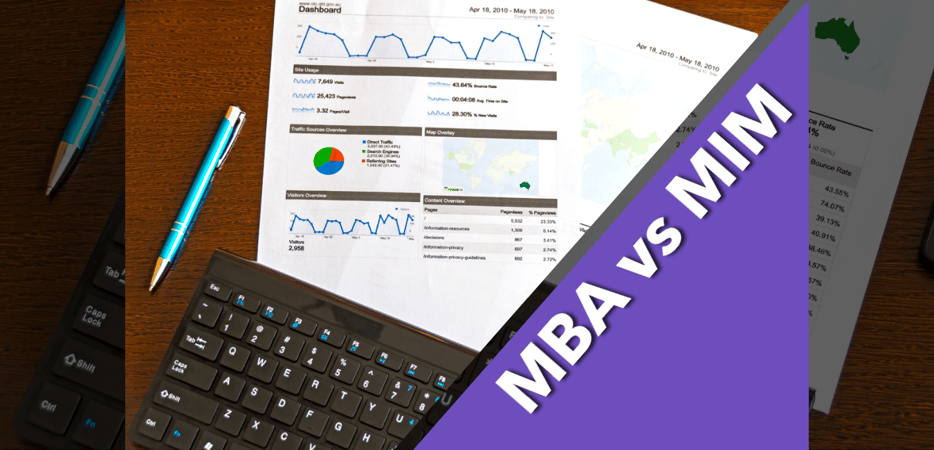MBA vs MIM: What’s The Difference?

Getting a higher education means better opportunities, but also means a significant time and money investment. This being said, it is important to choose the course that fits your needs and your profile. Here we want to give you a little help with that.
MIM: what is it?
An MIM is a Master’s in Management. This course usually takes 2 years to complete, and it is a master’s that has gained popularity over the last few years for young professionals who have little to no professional experience.
This degree focuses on the study of different management theories and not business as a whole. The study of complex theoretical concepts and quantitative analyses make an MIM more academically rigorous than other management courses.
MIM vs. MBA
Let’s differentiate an MIM from an MBA based on a few examples:
| MIM | MBA | |
| Fees: | $52,980 | $68,200 |
| Duration: | 10 months | 2 years |
| Format: | Full-time | Full-time |
| Work experience: | Up to 1 year | 5 to 6 years |
| GMAT: | Mandatory. 560-740 range. GRE and Tage Mage accepted. | Mandatory. |
| MIM | MBA | |
| Fees: | £32,620 (additional fee for the optional 4th term – £7,500) | £82,240 |
| Duration: | 12-16 months | 15, 18, or 21 months |
| Format: | Full-time | Full-time |
| Work experience: | Less than 2 years | 3 to 15 years |
| GMAT: | Mandatory. 600 minimum. GRE accepted. | Mandatory. 707 average. GRE accepted. |
| MIM | MBA | |
| Fees: | €28,500 | €68,735 |
| Duration: | 13 months | 12, 15, 18 months |
| Format: | Full-time | Full-time |
| Work experience: | Less than 2 years experience | 2 years minimum |
| GMAT: | 660 average. GRE accepted. | 660 average. GRE accepted (160/162). |
Admission Criteria and work experience
Usually, the GMAT is required for admission to both courses, except that the average score required for MBAs tends to be higher. In the case of MIMs, previous academic performance is more important and the type of degree required for admission may vary according to the course: Some courses only admit candidates with an undergraduate degree in business or economics; others look for the exact opposite, students who don’t have a degree in business or economics; and some others may favor candidates who have degrees with strong methodical structures (e.g. physics).
Professional work experience is more valuable when it comes to an MBA because it has a hands-on approach. On the other hand, the MIM takes the perspective of an observer or analyst, so you should apply to an MIM if you have less than 1.5 years of experience.
Fees
MIM fees tend to be lower than MBA fees. This can be related to work experience from the candidates and the duration of the course.
Age
The average MBA student age range goes from 28 to 32, while for MIM is significantly lower, at 23. This can be directly related to the work experience required to take the course. MBAs require more work experience (5 years on average) while MIMs candidates must have minimum work experience to go for a postgraduate degree at a younger age. MBA students are not older on average because people who are in their thirties and already have a good-paying job (and possibly a family) are less keen to leave that job, potentially move to another city, and invest time and money in an MBA.
Curriculum and Career Prospects
MIMs and MBAs prepare candidates for different things. An MBA has a more practical approach to train leaders in business and managers with strong soft skills, while an MIM is more academic, involving theoretical analysis and math.
MIM and MBA graduates tend to look for job positions with different descriptions and different positions in the hierarchy. In the case of MBAs, graduates are older and more experienced while MIM graduates are generally younger, and are rookies when it comes to practical purposes.
MBA vs. MIM Salary
Education and work experience are important factors in salary. In the case of MBA graduates, they count on considerably more experience than MIM graduates, which leads to a higher salary for the first group from the start.
According to the Financial Times, and MBAs weighted salary is 50% higher than the salary of an MIMs graduate. To be more specific, the top MBA school of 2018 (Stanford Business School) has a weighted salary of $214,742 while the top MIM school (University of St. Gallen) has a weighted salary of $108,621.
I already have an MIM and I want to apply for an MBA
If you already have an MIM degree, you might have to work a bit harder than your fellow candidates to be admitted to an MBA. At first glance, the admission team may think you don’t need an MBA, so you will focus on why you are applying and your objectives.
When filling your application, expose strong and compelling arguments as to why you aspire to get an MBA and what your career goals are, despite already having a strong understanding of business and management.
To sum it up…
– MBA and MIM are business and management degrees
– MBAs are for more experienced, accomplished professionals
– MIMs are for young professionals with little work experience
If you need help with the GMAT or the admissions process, we can help. For more information on our different GMAT products, see:
- GMAT private classes – see the stories of Will, Teddy, Jessica, and Nico and how they approached their GMAT journey with Merchant.
- Merchant Academy – a GMAT teaching innovation that makes taking the GMAT, like an MBA. Click to find out more about the Merchant Academy format.
- Merchant GMAT Hall of Fame – a gallery of some of our clients over the last eight years.
For admissions help, see some client stories on our admissions page.
Ready to Start?
Fill out the form, and a member of the Merchant Sales Team will be in contact with you shortly to discuss your MBA journey





